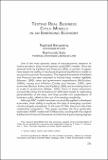Artículo
Testing real business cycle models in an emerging economy
Fecha
2005Resumen
One of the most dynamic areas of macroeconomic research in recent decades is that of real business cycle (RBC) models. Since the seminal work by Kydland and Prescott (1982), a number of papers have tested the ability of neoclassical general equilibrium models to account for economic fluctuations. The original framework of Kydland and Prescott has been extended to include labor market rigidities (Hansen, 1985), taxes and government expenditures (McGrattan, 1994b), money and inflation (Cooley and Hansen, 1995), open economies (Backus, Kehoe, and Kydland, 1995), and increasing returns to scale in production (Weber, 2000). Each of these extensions successfully solves the limitations of calibrated models in replicating particularities of the data, and they provide rich explanations of business cycles, albeit at the cost of increasing complexity.
Colecciones
Descargar


